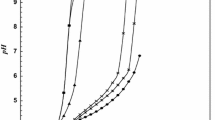Abstract
Complex formation constants were determined potentiometrically (by a ISE-H+, glass electrode) in the systems, M2+ – Lz – H+ [M2+ = (C2H5)2Sn2+, Lz = malonate, glycinate and ethylenediamine] at t = 25 ∘C and 0.1 mol-L−1≤ I/ ≤ 1 mol-L−1 in NaClaq (0.1 mol-L−1 ≤ I ≤ 0.75 mol-L−1 for the ethylenediamine system). Thermodynamic values of formation constants, at infinite dilution, are [± 95% confidence interval, Tβpqr refer to the equilibrium, pM2+ + qLz + rH+ = M p L q H r (2+z+r)]: for malonate, log10 Tβ110 = (5.47 ± 0.10); for glycinate, log10 Tβ110 = (9.54 ± 0.08), log10 Tβ111 = (12.97 ± 0.10); and for ethylenediamine, log10 Tβ110 = (10.47 ± 0.10), log10 Tβ120 = (16.17 ± 0.12) and log10 Tβ111 = (15.46 ± 0.10). The dependence on ionic strength of the formation constants was modeled by a simple Debye–Hückel type equation and by the SIT approach. By analyzing the stability of the species in the three different systems we found a simple additivity rule that can be expressed by the relationship: log10 K = 6.46 nN + 3.96 nO − 0.60 (nN2+ nO2), with a mean deviation, ε(log10 K) = 0.15 (K = equilibrium constant for the interaction of the organometal cation with the unprotonated or protonated ligand, nN = number of amino groups and nO = number of carboxylic groups of the ligand(s) involved in the formation reaction of complex species).
Similar content being viewed by others
References
J. J. Zuckerman, R. P. Reisdorf, H. V. Ellis, and R. R. Wilkinson, in Organometals and Organometalloids: Occurrence and Fate in the Environment, F. E. Brinckan and J. M. Bellama Eds. (ACS Symp., Series No 82, Washington, 1978), 388 pp., and refs. therein.
S. J. Blunden and A. Chapman, in Organometallic Compounds in the Environment, P. J. Craig Eds. (Longman, Harlow, Essex, England, 1986), 111 pp., and refs. therein.
P. J. Craig, Organometallic Compounds in the Environment, P. J. Craig, Ed. (Longman, Harlow, Essex, England, 1986), and refs. therein.
Y. Arakawa and O. Wada, in Metal Ions in Biological Systems, vol. 29, H. Siegel and A. Siegel Eds. (Marcel Dekker, New York, 1993), 101 pp., and refs. therein.
M. A. Champ and P. F. Seligman, Organotin. Environmental Fate and Effects, (Chapman & Hall, London, 1996), and refs. therein.
L. Pellerito and L. Nagy, Coord. Chem. Rev. 224, 111 (2002), and refs. therein.
C. Foti, A. Gianguzza, D. Milea, F. J. Millero, and S. Sammartano, Mar. Chem. 85, 157 (2004), and refs. therein.
C. Foti, A. Gianguzza, D. Milea, and S. Sammartano, Appl. Organomet. Chem. 16, 34 (2002), and refs. therein.
C. De Stefano, C. Foti, A. Gianguzza, and S. Sammartano, in Chemical Processes in Marine Environments, A. Gianguzza, E. Pelizzetti, and S. Sammartano Eds. (Springer-Verlag, Berlin, 2000), 213 pp., and refs. therein.
G. Biederman, in Dahlem Workshop on the Nature of Seawater, (Dahlem Konferenzen, Berlin, 1975), 339 pp.
C. De Stefano, P. Mineo, C. Rigano, and S. Sammartano, Ann. Chim. (Rome) 83, 243 (1993).
C. De Stefano, C. Foti, O. Giuffrè, P. Mineo, C. Rigano, and S. Sammartano, Ann. Chim. (Rome) 86, 257 (1996).
C. De Stefano, S. Sammartano, P. Mineo, and C. Rigano, in Marine Chemistry - An Environmental Analytical Chemistry Approach, A. Gianguzza, E. Pelizzetti and S. Sammartano (Eds.) (Kluwer Academic Publishers, Amsterdam, 1997), 71 pp.
F. Crea, A. De Robertis, and S. Sammartano, J. Solution Chem. 33, 497 (2004).
C. De Stefano, C. Foti, A. Gianguzza, and S. Sammartano, Chem. Spec. Bioavail. 7, 1 (1995).
A. De Robertis, C. Foti, O. Giuffrè, and S. Sammartano, J. Chem. Eng. Data 46, 1425 (2001).
K. Gajda-Schrantz, L. Nagy, T. Fiore, L. Pellerito, and T. Gajda, J. Chem. Soc. Dalton Trans. 152 (2002).
P. Surdy, P. Rubini, N. Buzas, B. Henry, L. Pellerito, and T. Gajda, Inorg. Chem. 38, 346 (1999).
C. De Stefano, A. Gianguzza, F. Marrone, and D. Piazzese, Appl. Organomet. Chem. 11, 683 (1997).
M. M. Shoukry, Talanta 43, 177 (1996).
Author information
Authors and Affiliations
Corresponding author
Rights and permissions
About this article
Cite this article
De Robertis, A., De Stefano, C., Milea, D. et al. Additivity Factors in the Binding of the Diethyltin(IV) Cation by Ligands Containing Amino and Carboxylic Groups at Different Ionic Strengths. J Solution Chem 34, 1211–1226 (2005). https://doi.org/10.1007/s10953-005-6196-0
Received:
Accepted:
Issue Date:
DOI: https://doi.org/10.1007/s10953-005-6196-0




